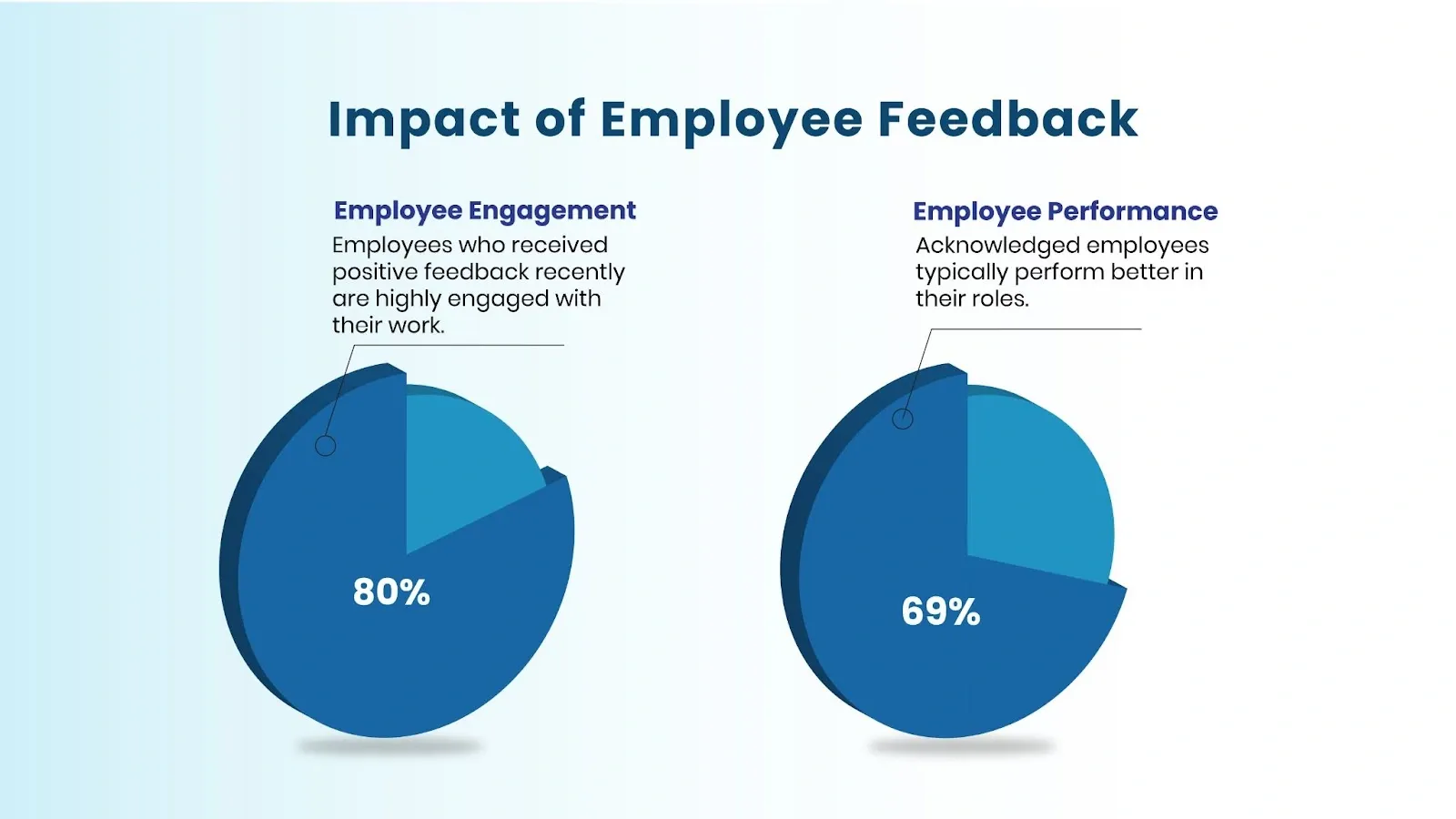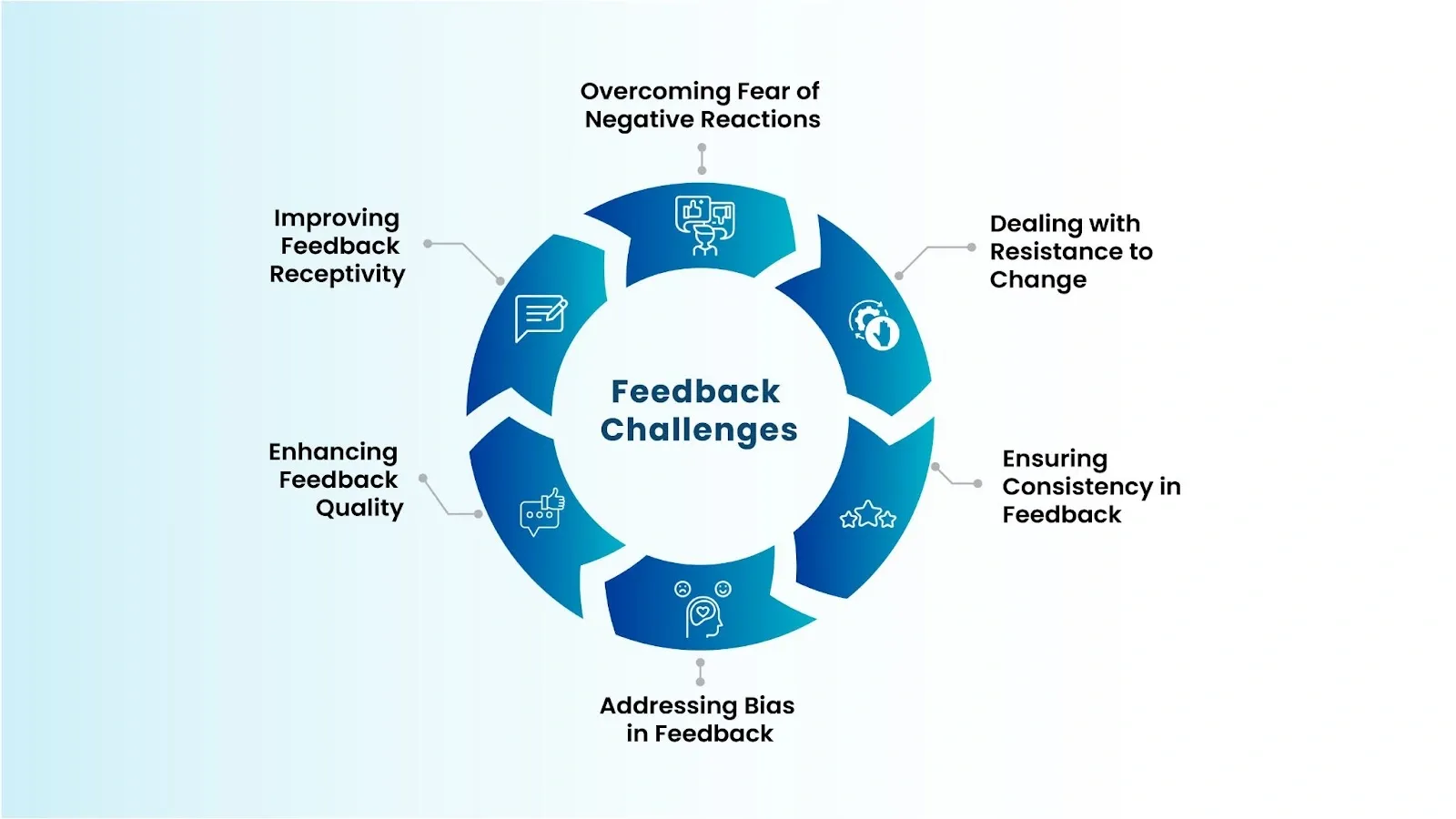Understanding Employee Feedback: Its Importance and Examples

In today's workplace, there's a big shift happening towards a friendlier, more feedback-oriented culture. Why?
Because feedback is like the secret essence for growth and success! It's all about continuous learning and keeping everyone engaged and motivated. With the help of modern tech, giving and getting feedback has become super easy and instant.
Plus, with teams being so diverse and spread out, especially with remote work, feedback helps everyone stay connected and on the same page. It's also about being open and honest, which builds trust within the team.

When employees receive meaningful feedback, it makes a big difference! In fact, 80% of employees who have gotten helpful feedback in the past week feel fully engaged and connected to their work.
Also Employees who are acknowledged by their management tend to perform 69% better in their roles.
And let's not forget feedback is key to polishing those all-important soft skills like communication and teamwork. So, in a nutshell, feedback is a big deal because it helps everyone grow, stay engaged, and work better together, which is what makes a workplace truly awesome!
In this blog, we will discuss the importance of employee feedback and provide some examples of how to write one.
Employee Feedback
Employee feedback is like a friendly chat about how you're doing at work. It's when your boss or coworkers share their thoughts on your performance, behavior, and contributions to the team. Think of it as getting pointers to help you do even better in your job.
There are different forms of employee feedback:
- Constructive Feedback
- Positive Feedback
- Corrective Feedback
- 360 Degree Feedback
- Real-Time Feedback
- Formal Feedback
- Informal Feedback
Importance of Employee Feedback
Employee feedback is a vital tool for any organization, playing a crucial role in various aspects of workplace dynamics. Here's a breakdown of its importance:
Enhancing Employee Engagement and Motivation:
Regular employee feedback helps keep team members engaged and motivated. When employees know their opinions matter and their work is recognized, they're more likely to be invested in their roles and the company's success.
Facilitating Continuous Improvement and Innovation:
Feedback fosters an environment where continuous improvement is encouraged. Employees who receive constructive feedback can innovate and refine their skills, contributing to the overall growth of the organization.
Strengthening Communication and Trust within Teams:
Open lines of communication, facilitated by employee feedback, help build trust among team members. This trust is essential for collaboration, problem-solving, and maintaining a healthy workplace culture.
Guiding Personal and Professional Development:
Feedback is a powerful tool for guiding employees' personal and professional development. It helps individuals understand their strengths and areas for improvement, allowing them to set informed goals and pursue relevant growth opportunities.
Identifying Issues and Resolving Conflicts Early:
Regular feedback helps identify potential issues and conflicts at an early stage. Addressing these concerns promptly can prevent them from escalating and affecting team dynamics and productivity.
Shaping a Positive Organizational Culture:
The importance of employee feedback extends to shaping a positive organizational culture. A culture that values and acts on feedback is likely to be more inclusive, adaptable, and resilient.
Informing Decision-Making and Strategic Planning:
Employee feedback provides valuable insights that can inform decision-making and strategic planning. Understanding employees' perspectives and experiences can lead to more informed and effective strategies.
Examples of Effective Employee Feedback in Action
Here are some examples of effective employee feedback in action, showcasing how it can be used in various situations to drive improvement and foster a positive work environment:
- Real-Time Feedback for Immediate Improvement: "I noticed how you handled that client call just now. Great job staying calm and offering solutions. Your approach really aligns with our commitment to excellent customer service."
- Constructive Criticism Leading to Skill Development: "Your report was well-researched, but I noticed a few areas where the data could be more clearly presented. Let's work on refining your data visualization skills to enhance the impact of your reports."
- Positive Reinforcement Boosting Morale and Productivity: "Your enthusiasm and creativity in the last project were outstanding. Your innovative ideas not only improved the project outcome but also inspired the team. Keep up the great work!"
- Peer-to-Peer Feedback Fostering Collaboration: "I really appreciate your willingness to help me with the presentation. Your insights made a big difference, and it's great to see such collaboration within our team."
- Customer Feedback Driving Service Excellence: "We received positive feedback from a client about your attentive service and problem-solving skills. It's great to see you applying our customer service principles so effectively."
- 360-Degree Feedback for Holistic Self-Awareness: "Your 360-degree feedback highlighted your strong leadership skills and ability to motivate the team. It also suggested areas for improvement in time management. Let's discuss how we can work on this together."
- Anonymous Feedback Ensuring Candid Insights: "The anonymous feedback we received emphasized the need for more open communication within the team. Let's address this by setting up regular check-ins where everyone feels comfortable sharing their thoughts."
Overcoming Challenges in Feedback Processes
Overcoming challenges in feedback processes is crucial for maintaining a positive and productive work environment. Here are some strategies for addressing common obstacles in employee feedback:

- Overcoming Fear of Negative Reactions: Encourage a culture where feedback is seen as a tool for growth. Remind employees that feedback is not a personal attack but an opportunity to improve and excel.
- Dealing with Resistance to Change: Emphasize the benefits of acting on feedback, such as enhanced skills and career advancement. Highlight success stories where feedback led to significant improvements.
- Ensuring Consistency in Feedback: Establish regular feedback cycles, such as weekly check-ins or monthly reviews, to ensure that employee feedback is an ongoing process rather than a one-time event.
- Addressing Bias in Feedback: Promote diversity and inclusion training to reduce unconscious bias. Encourage feedback from multiple sources to provide a more balanced perspective.
- Enhancing Feedback Quality: Train managers and employees on how to give and receive feedback effectively. Focus on making feedback specific, actionable, and constructive.
- Improving Feedback Receptivity: Foster an environment where employees feel valued and understood. Encourage active listening and open-mindedness when receiving feedback.
Best Practices for Giving and Receiving Feedback
Giving and receiving feedback is an essential part of maintaining a productive and positive work environment. Here are some best practices for making the most out of employee feedback:
- Fostering an Open and Safe Environment for Feedback: It's crucial to create a culture where employees feel comfortable giving and receiving feedback. This means establishing trust and ensuring that feedback is always given with the intention of helping the recipient grow.
- Ensuring Feedback is Specific, Actionable, and Timely: Good employee feedback should be clear and focused on specific behaviors or outcomes. It should provide actionable steps for improvement and be given promptly while the experience is still fresh.
- Setting KPIs: Use Key Performance Indicators (KPIs) to provide a clear framework for feedback. When employees understand how their performance is measured, they can better appreciate the relevance and importance of the feedback they receive.
- Encouraging a Growth Mindset and Receptiveness to Feedback: Cultivate a mindset within the team that views feedback as an opportunity for growth rather than criticism. Encourage employees to be open to feedback and to see it as a valuable tool for their personal and professional development.
- Training Managers and Leaders in Effective Feedback Techniques: Equip your managers and leaders with the skills to provide constructive and effective feedback. This can include training on communication styles, active listening, and how to frame feedback in a positive and supportive way.
- Using Modern Tools: Incorporate modern tools and platforms, such as getCREDIBLE, to streamline the feedback process. These tools can help gather, organize, and analyze feedback, making it easier to identify trends and areas for improvement.
By following these best practices, you can ensure that employee feedback is a constructive and valuable part of your organization's culture.
Introducing getCREDIBLE
getCREDIBLE is transforming the way professionals brand themselves with its innovative digital resumes. At the heart of this revolution is the 'Slate,' a dynamic document that grows with your career, ensuring your profile stays up-to-date and highlights your skills.
Its key features include;
- Instant updates
- AI-powered summaries of major accomplishments
- A professional ecosystem
- Milestone-based reviews and feedback
- A continuous feedback system for improvement
- A user-friendly interface that helps you craft an engaging professional story.
Conclusion
Focusing on employee feedback within an organization is crucial for creating a positive impression on managers and communicating your career ambitions. It allows them to see if your objectives match the expectations of your role.
Tools like getCREDIBLE are instrumental in highlighting your employee feedback, skills, and accomplishments to your superiors.
Register with getCREDIBLE today to take advantage of its cutting-edge features, ensuring your employee feedback is showcased effectively for a lasting impact.
